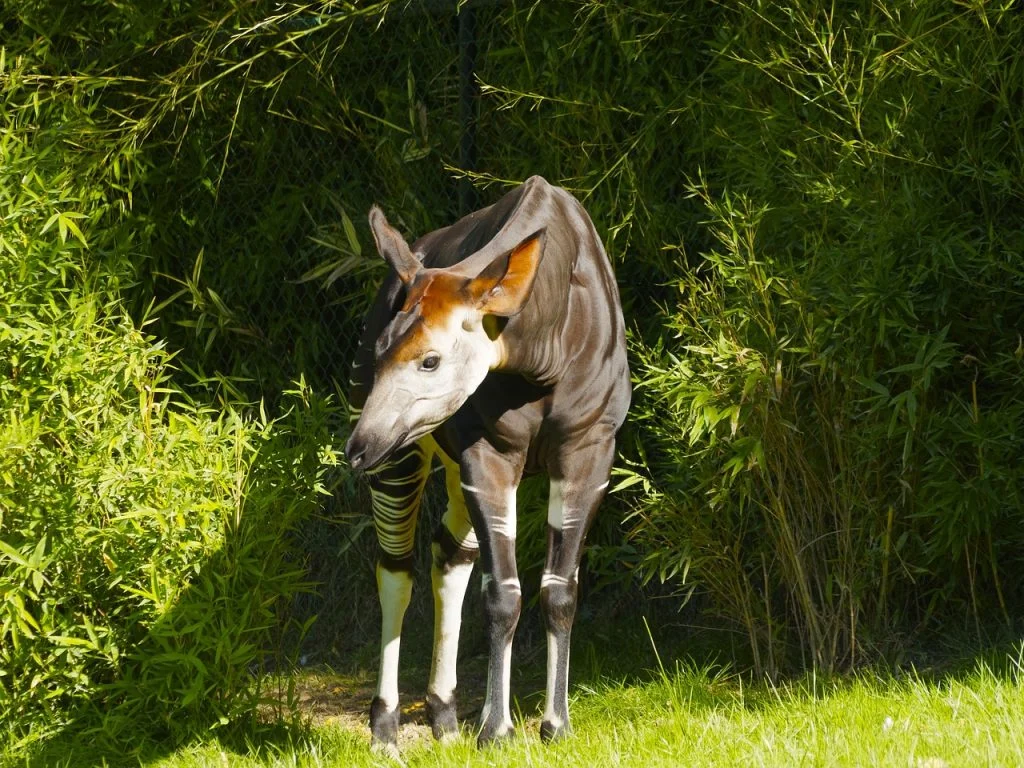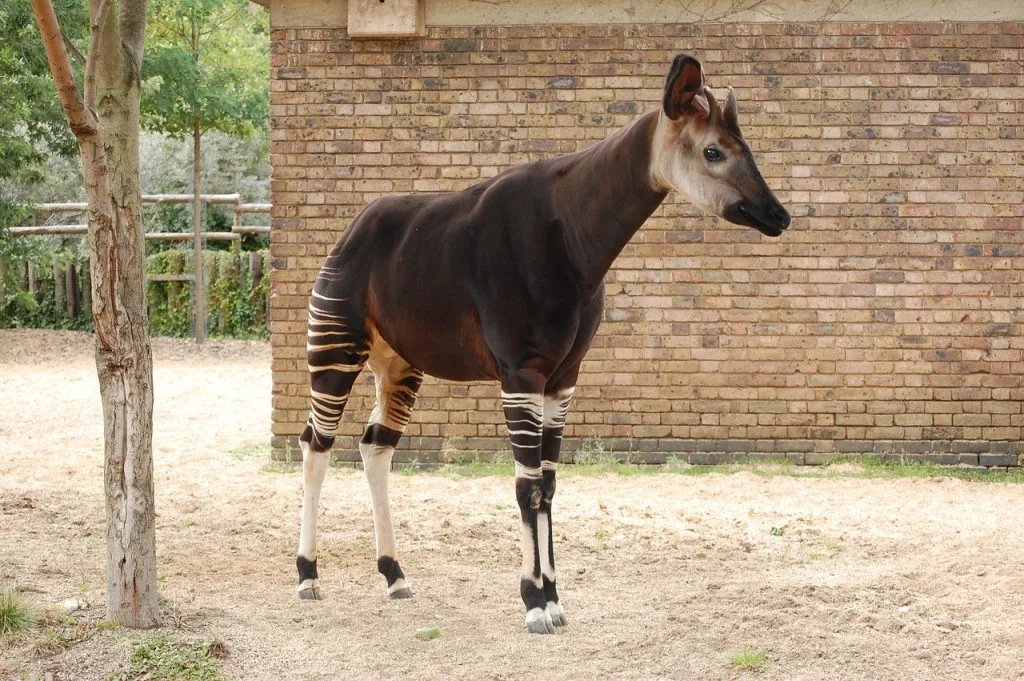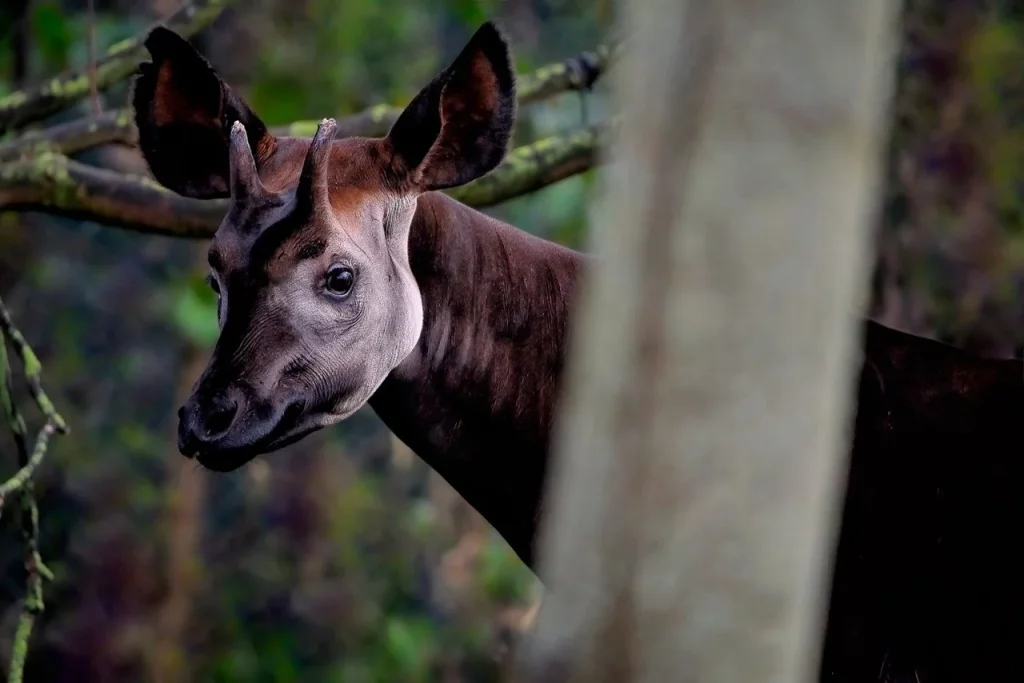Have you ever been so misunderstood that even Google gives you a questionable look? That’s the story of the okapi. During a research trip in the dense Ituri Rainforest, I tried explaining to a local guide that I was studying okapis, not zebras. He laughed for a solid minute before realizing I was serious.
These creatures are the introverts of the animal world, so elusive that even locals rarely spot them. As we explore 50 fascinating facts about the okapi, I’ll share why this shy, striped wonder deserves more than a passing glance. Ever felt like hiding from the world? The okapi is your spirit animal.
In the silence of the Congo, the Okapi’s gentle elegance whispers the poetry of the wild.
Carl Safina
Okapi Facts
Let’s explore all these hidden wonders together! As you learn through these facts about okapi, remember that a quiz awaits you at the end – a perfect chance to test your newfound knowledge.
- Scientific Name: The okapi’s scientific name is Okapia johnstoni.
- Habitat: Okapis primarily inhabit the rainforests of the Democratic Republic of Congo.
- Discovery: Western scientists recognized the okapi in 1901.
- Diet: Okapis are herbivores, mainly eating tree leaves and buds, grasses, ferns, fruits, and fungi.
- Physical Appearance: They have velvety, chocolate to reddish-brown fur, with white horizontal stripes on their legs.
- Related Species: The okapi is the only living relative of the giraffe.
- Conservation Status: Okapis are listed as Endangered on the IUCN Red List.
- Population: The exact population is unknown, but it is estimated to be in the thousands.
- Reproduction: Female okapis usually give birth to a single calf after a 14-16 month pregnancy.
- Lifespan: In the wild, okapis can live up to 20-30 years, and longer in captivity.
- Communication: They communicate through various vocalizations, postures, and scent markings.
- Hearing: Okapis have large, flexible ears which help them detect predators.
- Size: Adults typically stand about 1.5 meters (5 feet) tall at the shoulder.

- Weight: They can weigh between 200 and 350 kilograms (440-770 pounds).
- Tongue: Okapis have a long, prehensile tongue used for grasping leaves.
- Behavior: They are generally solitary animals, except during mating or mother-calf pairs.
- Hooves: Okapis have oily, spongy hooves that provide a good grip on wet, forest floors.
- Nocturnal: Okapis are primarily diurnal but may be active for a few hours at night.
- Deforestation: Loss of habitat due to deforestation is a significant threat to their survival.
- Predators: Main predators include leopards and humans (through poaching).
- Symbolism: The okapi is a national symbol of the Democratic Republic of Congo.
- Zoo Populations: They were first exhibited in a zoo in 1918 and are now found in zoos worldwide.
- Calves: Newborn calves spend the first few months of life hidden away in vegetation.
- Nursing: Calves are weaned at about six months old.
- Genetic Research: Okapis have been studied for insights into giraffe evolution and genetics.
- Cryptid: Before its recognition by science, the okapi was often considered a mythical creature.
- Conservation Efforts: Various conservation programs are in place to protect okapis in the wild.
- Unique Markings: Their leg stripes act as camouflage in the dappled light of the forest.

- Observation Difficulty: Okapis are elusive and rarely seen in the wild due to their dense rainforest habitat.
- Adaptations: Okapis have several adaptations for rainforest life, including a specialized diet and sensitive hearing.
- Social Structure: They have a loose social structure, with overlapping home ranges but little interaction.
- Conservation Parks: The Okapi Wildlife Reserve in the DRC is a major site for okapi conservation.
- First Discovery: The okapi was first known to the local indigenous people before its discovery by Western science.
- Mating: Mating rituals include neck rubbing and scent marking by both sexes.
- Facial Features: They have a distinctive facial structure similar to giraffes, with a long, flexible neck.
- Hybridization: There are no known instances of okapis hybridizing with other species.
- Feeding Habits: Okapis are browsers, feeding on a variety of plant species.
- Water Dependency: They are less dependent on water than other herbivores, obtaining moisture from their food.
- Seasonal Changes: Okapis show some seasonal changes in diet and activity but are not migratory.

- Specialized Diet: Their diet is high in fiber and low in energy, suitable for their forest environment.
- Threats: Besides deforestation, they are threatened by illegal mining, bushmeat trade, and civil unrest in their habitat.
- Discovery Controversy: There was initial skepticism about the okapi’s existence among some Western scientists.
- Research Challenges: Studying okapis in the wild is challenging due to their secretive nature and dense habitat.
- Genetic Studies: Genetic studies have helped clarify the evolutionary relationship between okapis and giraffes.
- Symbol in Zoos: Okapis are often used as a symbol for African wildlife conservation efforts.
- Public Awareness: Despite their unique nature, okapis are not as well-known as other African animals.
- Mythical Associations: In some cultures, okapis were associated with myths and legends about the African forest.
- Climate Change Impact: Climate change poses a potential threat to their rainforest habitat.
- Cultural Importance: Okapis hold a place of importance in the cultural heritage of some Congolese ethnic groups.
- Scientific Research: Okapis are subjects of ongoing scientific research to understand their ecology and behavior.
Okapi Myths

Now that we’ve explored some fun facts about okapis, let’s unravel the myths and discover what’s fact and what’s fiction in the mysterious world of these forest dwellers.
- Okapis Can’t Survive Outside the Rainforest
While okapis are native to the dense rainforests of the Congo, they have been successfully bred and cared for in zoos around the world. They do need specific conditions that mimic their natural habitat, like a diet rich in leaves and a quiet, secluded environment, but they can thrive outside their native rainforest with proper care. - Okapis Are a Type of Zebra
Despite their striped hindquarters, which might make them look like zebras, okapis are actually the closest living relatives of the giraffe. Their unique body shape and long necks are more similar to those of giraffes than to those of zebras. - Okapis Have No Natural Predators
While it’s true that their elusive nature and dense rainforest habitat provide some protection, okapis do face threats from natural predators. Leopards are the primary predators of okapis in the wild, posing a significant risk, especially to younger or weaker individuals. - Okapis Are Social Animals
Unlike some hoofed mammals that live in herds, okapis are quite solitary. They are rarely seen together, except during mating or when mothers are raising their calves. They communicate over long distances using infrasound, which is below the range of human hearing. - Okapis Are Common in the Wild
Unfortunately, this is far from true. Okapis are classified as endangered, with their numbers declining due to habitat loss, poaching, and mining activities in their natural habitat. Conservation efforts are crucial to protect these unique and mysterious animals.
No products found.
Okapi Quotes

Let me share with you some quotes about them from some notable figures.
The elusive beauty of the Okapi is a testament to the mysteries that nature still holds for us.
David Attenborough
Renowned naturalist Sir David Attenborough marvels at the enigmatic allure of the Okapi, highlighting the species’ elusive nature.
In the heart of the Congo, the Okapi stands as a symbol of the untamed wilderness and the importance of conservation.
Jane Goodall
Primatologist and conservationist Jane Goodall emphasizes the Okapi’s significance as a symbol of pristine wilderness, urging the need for conservation efforts.
The Okapi teaches us the art of blending in while standing out—a true master of survival in the rainforest.
Diane Fossey
Gorilla researcher Diane Fossey commends the Okapi’s ability to navigate the dense rainforest, showcasing its prowess in both camouflage and individuality.
As the forest’s shadowy guardian, the Okapi embodies the secrets and wonders hidden within the depths of the jungle.
George Schaller
Wildlife biologist George Schaller portrays the Okapi as a guardian of the forest, symbolizing the mysteries and wonders concealed in the heart of the jungle.
The Okapi, with its zebra-like legs and giraffe-like neck, is a masterpiece of evolutionary ingenuity.
Richard Dawkins
Evolutionary biologist Richard Dawkins marvels at the Okapi’s unique combination of features, highlighting the species as a testament to the wonders of natural selection.
Okapi FAQ

From the heart of the forest to these frequently asked questions, your journey with okapis continues. Absorb this last piece of information well—they’re your secret weapon for the quiz that’s just up ahead!
- What is an Okapi?
The okapi is a unique mammal native to the rainforests of the Democratic Republic of the Congo in Central Africa. It’s known for its striking appearance, which includes deep brown fur, white-striped hindquarters resembling a zebra, and a long, giraffe-like neck. Despite its zebra-like stripes, the okapi is actually the only living relative of the giraffe. - How Many Okapis Are Left in the World?
The exact number of okapis remaining in the wild is uncertain, but it’s estimated to be between 10,000 and 50,000. Their numbers are challenging to determine accurately due to their elusive nature and dense rainforest habitat. - Why Are Okapis Endangered?
Okapis face several threats, leading to their status as an endangered species. Key factors include habitat loss due to deforestation, illegal mining, and human encroachment. Additionally, they are threatened by poaching for their skin and meat. Conservation efforts are underway, but the challenges in their remote and dense habitat make protection efforts complex. - What is the Lifespan of an Okapi?
In the wild, okapis usually live for around 20 to 30 years. In captivity, with proper care and absence of predators, they can live slightly longer, sometimes reaching up to 30 years or more. - What Do Okapis Eat?
Okapis are herbivores, primarily feeding on tree leaves and buds, grasses, ferns, fruits, and fungi. Their long, flexible tongues, which can be up to 18 inches long, help them strip leaves from branches and groom themselves.
No products found.
Okapi Trivia

Welcome to the Ultimate Okapi Quiz! Remember, if you don’t get any questions right, an okapi might just appear to question your animal knowledge in person!
Conclusion
Who knew learning about okapis could be such a wild ride? From their zebra-like legs to their giraffe cousins, these creatures are the epitome of nature’s creativity. It’s like Mother Nature threw a bunch of animal parts into a blender and out popped an okapi.
But let’s be honest, isn’t their oddball charm what makes them so endearing? So, have you decided to adopt an okapi as your spirit animal yet, or are you still stuck on unicorns? Let me know in the comments.
3 Sources Used For This Article12 Incredible Facts About Okapis – Safari Partner
Okapi is A Fascinating Blend of Giraffe and Zebra – Kenzly


